Mitigation of septic shock in mice and rhesus monkeys by human chorionic gonadotrophin-related oligopeptides
- PMID: 20345979
- PMCID: PMC2883119
- DOI: 10.1111/j.1365-2249.2010.04112.x
Mitigation of septic shock in mice and rhesus monkeys by human chorionic gonadotrophin-related oligopeptides
Abstract
The marked improvement of several immune-mediated inflammatory diseases during pregnancy has drawn attention to pregnancy hormones as potential therapeutics for such disorders. Low molecular weight fractions derived from the pregnancy hormone human chorionic gonadotrophin (hCG) have remarkable potent immunosuppressive effects in mouse models of diabetes and septic shock. Based on these data we have designed a set of oligopeptides related to the primary structure of hCG and tested these in models of septic shock in mice and rhesus monkeys. We demonstrate that mice exposed to lipopolysaccharide (LPS) and treated subsequently with selected tri-, tetra-, penta- and hepta-meric oligopeptides (i.e. MTR, VVC, MTRV, LQGV, AQGV, VLPALP, VLPALPQ) are protected against fatal LPS-induced septic shock. Moreover, administration of a cocktail of three selected oligopeptides (LQGV, AQGV and VLPALP) improved the pathological features markedly and nearly improved haemodynamic parameters associated with intravenous Escherichia coli-induced septic shock in rhesus monkeys. These data indicate that the designed hCG-related oligopeptides may present a potential treatment for the initial hyperdynamic phase of septic shock in humans.
Figures
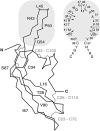
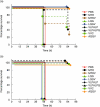


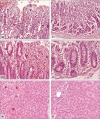
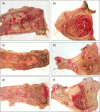
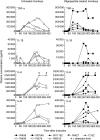
Similar articles
-
Inhibition of septic shock in mice by an oligopeptide from the beta-chain of human chorionic gonadotrophin hormone.Hum Immunol. 2002 Jan;63(1):1-7. doi: 10.1016/s0198-8859(01)00372-x. Hum Immunol. 2002. PMID: 11924526
-
Synthetic human chorionic gonadotropin-related oligopeptides impair early innate immune responses to Listeria monocytogenes in Mice.J Infect Dis. 2010 Apr 1;201(7):1072-80. doi: 10.1086/651134. J Infect Dis. 2010. PMID: 20170375
-
Synthetic oligopeptides related to the [beta]-subunit of human chorionic gonadotropin attenuate inflammation and liver damage after (trauma) hemorrhagic shock and resuscitation.Shock. 2009 Mar;31(3):285-91. doi: 10.1097/SHK.0b013e31817fd62a. Shock. 2009. PMID: 18654091
-
Human chorionic gonadotropin: a model molecule for oligopeptide-based drug discovery.Endocr Metab Immune Disord Drug Targets. 2011 Mar;11(1):32-53. doi: 10.2174/187153011794982031. Endocr Metab Immune Disord Drug Targets. 2011. PMID: 21352093 Review.
-
Dissection of systems, cell populations and molecules.Scand J Immunol. 2005 Jul;62 Suppl 1:62-6. doi: 10.1111/j.1365-3083.2005.01611.x. Scand J Immunol. 2005. PMID: 15953186 Review.
Cited by
-
How to Combat Gram-Negative Bacteria Using Antimicrobial Peptides: A Challenge or an Unattainable Goal?Antibiotics (Basel). 2021 Dec 7;10(12):1499. doi: 10.3390/antibiotics10121499. Antibiotics (Basel). 2021. PMID: 34943713 Free PMC article. Review.
-
Outlining key inflammation-associated parameters during early phase of an experimental gram-negative sepsis model in rhesus macaques (Macaca mulatta).Animal Model Exp Med. 2019 Oct 8;2(4):326-333. doi: 10.1002/ame2.12087. eCollection 2019 Dec. Animal Model Exp Med. 2019. PMID: 31942564 Free PMC article.
-
Study of the Antimicrobial Activity of the Human Peptide SQQ30 against Pathogenic Bacteria.Antibiotics (Basel). 2024 Feb 1;13(2):145. doi: 10.3390/antibiotics13020145. Antibiotics (Basel). 2024. PMID: 38391531 Free PMC article.
-
A randomized double-blind, placebo-controlled clinical phase IIa trial on safety, immunomodulatory effects and pharmacokinetics of EA-230 during experimental human endotoxaemia.Br J Clin Pharmacol. 2019 Jul;85(7):1559-1571. doi: 10.1111/bcp.13941. Epub 2019 May 23. Br J Clin Pharmacol. 2019. PMID: 30919998 Free PMC article. Clinical Trial.
-
Pharmacokinetics, safety and tolerability of the novel β-hCG derived immunomodulatory compound, EA-230.Br J Clin Pharmacol. 2019 Jul;85(7):1572-1584. doi: 10.1111/bcp.13942. Epub 2019 Jun 2. Br J Clin Pharmacol. 2019. PMID: 30924163 Free PMC article. Clinical Trial.
References
-
- Beeson PB. Age and sex associations of 40 autoimmune diseases. Am J Med. 1994;96:457–62. - PubMed
-
- Whitacre CC, Reingold SC, O’Looney PA. A gender gap in autoimmunity. Science. 1999;283:1277–8. - PubMed
-
- Adcock EW, 3rd, Teasdale T, August CS, et al. Human chorionic gonadotropin: its possible role in maternal lymphocyte suppression. Science. 1973;181:845–7. - PubMed
-
- Contractor S, Davies H. Effect of human chorionic somatomammotrophin and human chorionic gonadotrophin on phytohaemagglutinin-induced lymphocyte transformation. Nat New Biol. 1973;243:284–6. - PubMed
-
- Muyan M, Boime I. Secretion of chorionic gonadotropin from human trophoblasts. Placenta. 1997;18:237–41. - PubMed
Publication types
MeSH terms
Substances
LinkOut - more resources
Full Text Sources
Other Literature Sources
Medical

